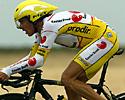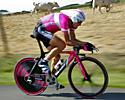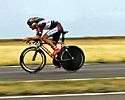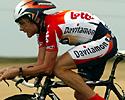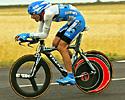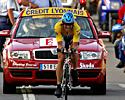
Recently on Cyclingnews.com |
|
|
View from the lab - Ric Stern's Tour de France sports science
British ABCC coach Ric Stern (www.cyclecoach.com) is a regular contributor to Cyclingnews' Form & Fitness section along with being a full time coach. Still an active rider when time allows, Ric will be providing a physiological insight into the challenges that face the riders in the Tour.
July 23, 2005: Getting the TT right - and wrong
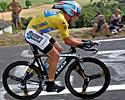
|
Today's time trial was different in more ways than one to the opening time trial on stage one. This was a long time trial compared to the comparative shortness of stage 1. The time trial was up and down today compared to the virtually pan flat stage one, and Jan Ullrich didn't suffer a crushing defeat. However, of course there were some similarities - it required a huge effort by the riders, the riders used lots of aerodynamic equipment, and Michael Rasmussen put in another poor time trial performance (albeit, one hundred places better than the opening stage).
TT essentials: the importance of positionIn flat, rolling, or hilly TT (not a mountain TT) the majority of the forces that have to be overcome to enable you to move forward as fast as possible are related to air drag. That means you need a good a good aero position and kit if you want to maximise your performance. The majority of races won't get a chance to go to a wind tunnel and have their positioned optimised. However, there are a few basic guidelines that can be used in the absence of a wind tunnel. Get low at the front end, have your forearms parallel to the road, and your forearms in front of your thighs when viewed from the front. Many riders sit too upright and have their arms pointing down - this will slow you down |
|||
|
|
||
|
On the other hand, when viewed from the side you should aim to have your acromion process at the same height or up to ~ 10% higher (slope) than your greater trochanter. Your acromion process is the 'knobbly' bone on the top of your shoulder, while your greater trochanter is the point around which your thigh rotates. See this image and this one here . Below are some good positions, though in the first one Jan Ullrich's arms could probably do with being pointed up a little. |
|||
|
|
||
|
|
||
|
|
||
Whether it's a short time trial or a long one (assuming a TT is more than about 90-secs in duration) the limiting factors are very similar: sustainable power output. Of course, it's not just about power output, there are other factors as well: body shape, size and your position, bicycle equipment, body mass (in a hilly TT), bike handling skills and pacing skills.
We saw that Michael Rasmussen lacked some skills today, as well, as the raw power required to time trial at the highest level. Not only did he crash once due to poor handling skills on a descent, but it's possible that his first crash (note: I'm speculating. I do this a lot!) was due to anxiety. As Michael would have known he was under direct pressure from Jan, it's certainly possible that he started in a very anxious state. This would have meant he was possibly not in control - he was riding beyond either his physical limits at the early roundabout or his skill level (as he may have felt he would lose time in the corners) and this led to early demise.
Once you've experienced a crash under these circumstances it can be hard to rein your thoughts in and negative self-talk can cause further issues as panic sets in. If you do experience an episode like this, it can be crucial to take a second and a few deep breaths (even if that means coasting for a few seconds) and realign your thoughts and start to concentrate on what you need to do rather than worrying about other people (which is out of your control). For example, this could be thinking positive thoughts about pedalling smoothly or maintaining a specific power output or heart rate zone and then zoning in to your effort.
On a technical circuit such as stage 20, which twists and turns, and climbs and descends, it's especially important to pre ride the circuit and to make mental note of which lines you should take through a corner, or at what speed you can take a corner at. Ideally, you should also note road surfaces, areas where you may be exposed to winds, and how steep the climbs and descents are.
If you reconnoitre the circuit with plenty of time (as I suspect Lance and Jan did) you can then mentally play the circuit over in your head. This will allow you to 'practice' the corners and other difficult areas so that you know where to brake or accelerate, etc. We can see that several riders over-cooked a very sharp hairpin corner including Ivan Basso. This may have dented his confidence for later in the race.
Another skill that a good time triallist should possess is the ability to pace a course correctly. That is, they do not 'blow' before the finish. You should aim to arrive at the finish having exhausted yourself. This involves two aspects of TTing: learning how to do as much work as possible, and pacing the hills, the descents and the flats to the best of your ability.
In a flat time trial you should you should aim to ride at an even effort trying to maintain a constant power output at an effort you know you can just hold for the duration of the event. On a circuit like stage 20, or where there's variable winds it can pay dividends to ride at a varying intensity - higher than average TT power on the hills and into headwinds, and below average on descents. The exact intensity that you ride at will depend on many factors including your fitness, and ability to push past your average TT power and the exact topography of the course.
2005 entries - the Tour de France
- July 28 - Stage 21 - What it takes
- July 23 - Stage 20 - Getting the TT right - and wrong
- July 22 - Stage 19 - The perfect break
- July 21 - Stage 18 - High intensity and fatigue
- July 19 - Stage 16 - Maintaining an attack
- July 17 - Stage 15 - Tour's biggest day
- July 16 - Stage 14 - Attacks keep coming
- July 15 - Stage 13 - Positive thoughts
- July 14 - Stage 12 - Hot, hot, hot!
- July 13 - Stage 11 - Big efforts uphill
- July 12 - Stage 10 - Number crunching
- July 7 - Stage 6: The dynamics of a breakaway
- July 6 - Stage 5: Coming back after a TT
- July 5 - The TTT - Man, machine and team
Previous Cyclingnews features by Ric Stern
- Winter Training
- Weight training and cycling - The Great Debate
- Power zone training - How to set training levels with a power meter
- Ric Stern also answers Cyclingnews readers' questions in our Form & Fitness Q&A section


